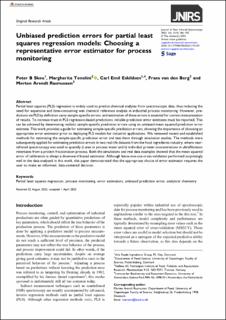| dc.contributor.author | Skou, Peter B | |
| dc.contributor.author | Tonolini, Margherita | |
| dc.contributor.author | Eskildsen, Carl Emil Aae | |
| dc.contributor.author | Berg, Frans van den | |
| dc.contributor.author | Rasmussen, Morten Arendt | |
| dc.date.accessioned | 2023-08-08T12:18:24Z | |
| dc.date.available | 2023-08-08T12:18:24Z | |
| dc.date.created | 2023-07-10T14:58:49Z | |
| dc.date.issued | 2023 | |
| dc.identifier.citation | Journal of Near Infrared Spectroscopy. 2023, 31 (4), 186-195. | |
| dc.identifier.issn | 0967-0335 | |
| dc.identifier.uri | https://hdl.handle.net/11250/3083048 | |
| dc.description.abstract | Partial least squares (PLS) regression is widely used to predict chemical analytes from spectroscopic data, thus reducing the need for expensive and time-consuming wet chemical reference analysis in industrial process monitoring. However, predictions via PLS by definition carry sample-specific errors, and estimation of these errors is essential for correct interpretation of results. To increase trust in PLS regression-based predictions, reliable prediction error estimates must be reported. This can be achieved by determining realistic sample-specific prediction errors using an unbiased mean squared prediction error estimate. This work provides a guide for estimating sample-specific prediction errors, showing the importance of choosing an appropriate error estimator prior to deploying PLS models for industrial applications. We reviewed recent and established methods for estimating the sample-specific prediction error and test them through simulation studies. The methods were subsequently applied for estimating prediction errors in two real-life datasets from the food ingredients industry, where near-infrared spectroscopy was used to quantify i) urea in process water and ii) individual protein concentrations in ultrafiltration retentates from a protein fractionation process. Both the simulations and real data examples showed that the mean squared error of calibration is always a downward biased estimator. Although leave-one-out-cross-validation performed surprisingly well in the data analysed in this work, this paper demonstrated that the appropriate choice of error estimator requires the user to make an informed, data-centered decision. | |
| dc.language.iso | eng | |
| dc.title | Unbiased prediction errors for partial least squares regression models: Choosing a representative error estimator for process monitoring | |
| dc.title.alternative | Unbiased prediction errors for partial least squares regression models: Choosing a representative error estimator for process monitoring | |
| dc.type | Peer reviewed | |
| dc.type | Journal article | |
| dc.description.version | publishedVersion | |
| dc.source.pagenumber | 186-195 | |
| dc.source.volume | 31 | |
| dc.source.journal | Journal of Near Infrared Spectroscopy | |
| dc.source.issue | 4 | |
| dc.identifier.doi | 10.1177/09670335231173139 | |
| dc.identifier.cristin | 2161729 | |
| dc.relation.project | EC/H2020/801199 | |
| cristin.ispublished | true | |
| cristin.fulltext | original | |
| cristin.qualitycode | 1 | |
